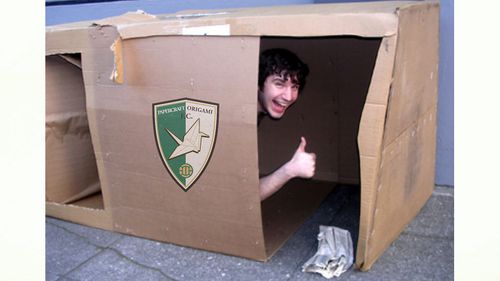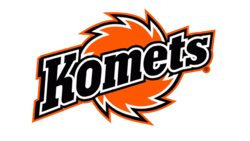| No. & Position
|
Name & Origin
|
Description
|
| 35
|
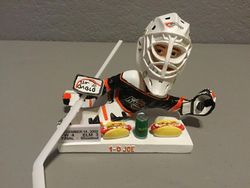
Joe Franke
"1-0 Joe"
|
https://youtu.be/bqRxW44MMO0
An equipment manager for the Komets, who suddenly was thrust into a game against the Elmira Jackals on December 14th, 2002, as an emergency goaltender when main goalie Pokey Reddick, already suffering from illness, couldn't continue playing. He scored an assist that game, and held off Elmira all through the OT period, leading into a penalty shootout. The video above contains his entire professional hockey career, and one of the greatest moments in Komets history. He is also the proud owner of a Stanley Cup ring as the assistant equipment manager for the 1990-91 Pittsburgh Penguins, and worked for the N.Y. Islanders from 2008 to 2010. Currently, Joe is still with the Komets, tending to the sticks, skates, and gear that the Komets players wear every winter.
|
| 52
|
Allen County War Memorial Coliseum
"The Concrete Jungle"
|
The Memorial Coliseum seats 10,480 for "the hottest sports ticket in town". Yes, the Komets have called this place home ever since it was built in 1952. It was also the home of the current-day Detroit Pistons, and brings up to 13,000 to watch the NBA G-League's Fort Wayne Mad Ants. From Elvis Presley and Louis Armstrong to KISS, AC/DC, Metallica, and especially Guns n' Roses, thousands of concerts have been held here in what Komets fans have called "The Jungle" for decades. Welcome to the jungle, baby. You're gonna die.
|
| 30
|
Robbie Irons
"Three Minute Man"
|
Born in Toronto, ON, Irons was a fine goaltender, with the best reflexes of mostly any Komet, let alone Komet goalies. For most hockey players, making it into the NHL is a dream come true. For Robbie Irons, he was able to get on the ice and play goaltender for the fairly new St. Louis Blues in 1968. Although he only played in one game for just three minutes (a former NHL record for shortest career by a goaltender) as the real substitute goalie was suiting up, his time on the ice was enough to solidify his status as one of the few Komets alumni to play in the NHL. His career with the Komets was an incredible one, and he is widely regarded as one of the best goalies to ever skate in front of a Fort Wayne Komets net. After playing with the Komets, Irons would become an sports analyst for he team he played for, and would join Bob Chase as part of the Radio Rinkside crew in 1983.
|
| 90
|
>Albany Choppers
"The Death of the Old Komets"
|
In the world of pro hockey, teams will move about should they feel the need to, for many reasons regardless of the level of play. When the owner of the Komets, gravel magnate David Welker, saw a shiny new stadium in Albany, New York, he wanted to go there, and he took away a team rich in Fort Wayne's sports history during the 1990 offseason, renaming it the Albany Choppers, a name granted by the sponsorship of a New York supermarket chain (Price Chopper), only for that same team to roll over and die in the middle of the 1990-91 IHL season. However, Stephen J. Franke, a very influential businessman in the area, quickly made plans to buy the neighboring Flint Spirits and relocate them to Fort Wayne, and he and his family did it within 48 hours of the old team leaving.
|
| 18
|
Glenn "Rob" Laird
"The Scout"
|
Born in Regina, SK, he was a tenacious winger known for his aggressive style on the ice and no-nonsense attitude off of it. He was to become an NHL mainstay, but a broken leg during Pittsburgh Penguins training camp soured his draftability. He would still be drafted 116th overall in 1974 by the Penguins, and drafted 29th overall in the WHA Amateur Draft by the Fighting Saints of Minnesota, but after he was sent down to Fort Wayne, and after the Penguins cut ties with the Komets, Laird stayed with the team and played for five seasons. He would play just one game in the NHL in the 1979-80 season with the Minnesota North Stars, retire in 1982, and come back out of retirement in 1983 to play three more seasons with the Komets. Today, he works as a scout for the NHL's L.A. Kings, even getting the chance to hoist Lord Stanley above his head after the Kings won it in 2012.
|
| 6
|
Lionel Repka
"Choo Choo"
|
Born in Edmonton, AB, Repka was known as a gritty defenseman with a heart of gold. When he was signed by the Fort Wayne Komets, he played nowhere else in professional hockey. His pro career, spanning 740 games across 11 seasons, with two Komets championships in 1963 and 1965, was a storied legacy that few Komets players, let alone Komets defensemen, would be able to follow. He was named the IHL's top defenseman for his outstanding contributions to the 1963 IHL champions. Not only was he a great player on Fort Wayne's ice, but he would also become a mentor to local hockey talent, and was easily one of the fan favorite Komets players of the 60's.
|
| 16
|
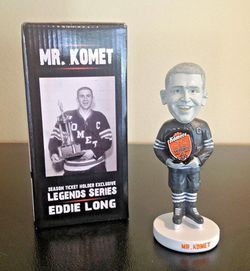
Edwin "Eddie" John Long
"Mr.Komet"
|
Born in Ottawa, ON, Eddie Long became a professional hockey player in 1952, after he signed with a brand new team from Fort Wayne, Indiana, called the "Komets". Though he never made it into one of the six NHL clubs of the time, he amassed an impressive 858 game career, playing with the Fort Wayne Komets for 857 of them, for 14 long seasons. Wrote Ben Tenny of the News-Sentinel, 1952: "It didn't take me long to see that the young short skater who was wearing No. 16 on his white jersey had that desire to win and get ahead that makes some athletes outstanding. If the play of this youngster is typical of the play fans will see in the International Hockey League, hockey will make it in Fort Wayne." Looking back 67 years later, Tenny's assumption was most certainly proven correct. His jersey, and the number 16, has never been worn by any other Komet player in the club's existence.
|
| 4
|
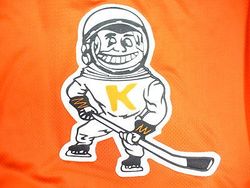
Captain Komet
"The Smug Spaceman"
|
You mad, /hoc/?
Captain Komet has been a figurehead of the team even before the beginning of the 1952 season, part of the brainchild of team founders Ernie Berg and Harold Van Orman. The Komets were named so for the desire to come up with a team name that embodied "speed, excitement, and flashiness". Berg spelled the "Komets" with a K in honor of his wife Kay. The name stood the test of time. However, the spaceman didn't, but he would sporadically show up on retro night jerseys and other promotions over the decades. He did, however, come back into regular usage after the Apollo 11 landed on the moon, when astronauts quickly became hip and trendy. In 2017, a brand new Captain Komet adorned alternate Komets jerseys, only this time, the smug smile of the spaceman was replaced with a stunning new look and pose fit for a hockey team looking to intimidate the opposition.
|
| 40
|
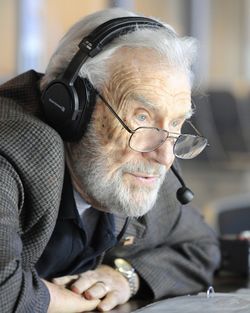 Robert "Bob Chase" Wallenstein Robert "Bob Chase" Wallenstein
"The Voice of Minor League Hockey"
|
Born in Negaunee, MI, in January 1926, Bob Chase would grow up with hockey, becoming a long-lasting and recognizable on-air voice for not just the Komets, but for the city of Fort Wayne as well. He used the maiden name of his wife for radio broadcasting, and for 63 seasons, Chase called the play-by-play action of Komet hockey on WOWO 1190 AM beginning in 1953, the Komet's second year of existence. Back in 1954, when WOWO's nighttime audience spanned from eastern Indiana and all of Michigan, expanding eastward to the size of nearly the entire US east coast, touching western Maine, northeastern Florida, and everywhere in between, it meant that Bob, being heard by 28 states and half of Canada on WOWO radio, was a recognizable and welcome voice during nighttime Komet hockey games, a tradition dubbed "Radio Rinkside" for his immersive style of play-by-play commentary. Of the 566 playoff games in the Komets' 67 year history, Bob was present for and called 526 of them. He turned down several NHL teams that wanted his timeless "Radio Rinkside" personality, including the Golden Seals, North Stars, Red Wings, Bruins, Blues, and Capitals, preferring to stay with the city and the team he called home. His unending service to the sport of hockey in America earned him the Lester Patrick Award in 2012. Only one man, Vin Scully, who called play-by-play for 67 seasons with the MLB's Brooklyn/L.A. Dodgers, has had a longer broadcasting tenure with a single franchise. Unfortunately, Bob would pass away on November 24th, 2016, at the age of 90. His legacy with the Komets will never be forgotten.
|
| 0

|
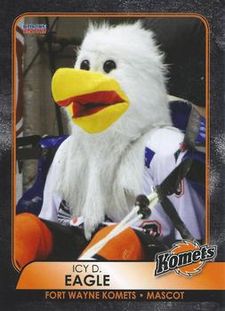
Icy D. Eagle
"The Mascot"
|
Every team in professional sports needs a way to connect with a younger audience and shape them into the fans of the next generation, and the solution for many is a team mascot. Oddly enough, the Komets never had one, or felt the need to have one, for 40 years, letting their perennial postseason caliber play and their history be the main attraction. Meanwhile, in Salt Lake City, UT, during the 1993-94 IHL season, Icy D. Eagle was introduced, a new mascot that would help rally the fans of the Salt Lake Golden Eagles, a dwindling franchise that had not seen much success in the old IHL since their glory years of back-to-back Turner Cup wins in 1987 and 1988. The team was on the decline, but as luck would have it, he would grace the Memorial Coliseum ice during the 1994 IHL All-Star Game, to a crowd that quickly embraced his wild antics and enthusiasm. After the Golden Eagles went under and folded in the 1994 off-season, the Komets convinced Icy to take a flight to stay in Fort Wayne, to which he accepted. Over the years, Icy has brought fun and entertainment to the Komet crowd, and as the face of the franchise, has had numerous sightings outside the Memorial Coliseum for local school benefits, charities, and festivals around the Fort Wayne area. His favorite toys include his trusty popcorn launcher and his four-wheeler.
|



 Robert "Bob Chase" Wallenstein
Robert "Bob Chase" Wallenstein
